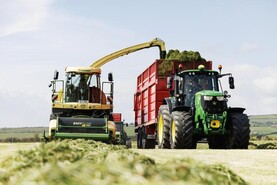With the necessity to get young stock outdoors and dwindling fodder stocks, many farmers were forced to turn animals out to tender fields and may have done some damage to the sod in the process this spring.
Minor poaching (less than baby finger length) will fix itself in one grazing rotation provided growth conditions are good. After a moderate level of poaching, we can broadcast grass seed (via fertiliser spreader) once ground dries. We need a relatively open sward to be successful here – soil to seed contact is vital. We should also avoid times of very rapid grass growth as existing plants will shade out our young plant and reduce establishment rates. A good time to broadcast seed is right before animals are going in to the paddock as they will help to work seeds down into the soil and induce germination.
By the time the animals come for their second grazing in our broadcasted plot, the new plants will be too small to be eaten but will benefit hugely from the extra sunlight they receive when existing material is cleared away.
After severe poaching, we need to think about a full reseed and we can either stitch seed in, direct drill or plough.
Stitching in
Stitching in requires specialised equipment but, as it scratches and places the seed directly onto the soil surface, the prospect of a successful germination are greatly enhanced. Stitching is less vulnerable to weather compared with ploughing as the seed bed is firm and down in a one pass operation.
Spraying the sward with glyphosate to kill off weeds and unproductive grass is advisable, but may not be entirely necessary. Spraying will increase the cost of reseeding and, if carried out, it is beneficial to apply lime in advance as dead grass becomes very acidic. A dry run of the grass harrow will remove dead matter from the seed bed and expose more soil for seed contact.
Grass seed should be applied at one bag/acre with sowing carried out in both horizontal and vertical directions.
As the soil surface is not disturbed, the grazing paddock can carry stock once the grass seed is firmly established and anchored.
Stitching can be carried out in spring, summer and autumn and works best during periods of low growth or after silage has been harvested.
Management after stitching the seed is crucial. The sward must be grazed tight throughout the season to encourage seedling development. Only graze with light weanlings or sheep and limit each grazing to three days every two weeks.
Direct drilling
Direct drilling grass seed is very similar to stitching in, but as it places the seed directly into the soil, establishment of new grass seedlings is higher. Often one or two runs of a power harrow is used to create a tilth in the top two inches and seed is dispersed on the surface. Management after sowing is similar to stitching in and slug pellets are advisable.
Ploughing
Conventional reseeding offers multiple benefits, but will have equally as many drawbacks. Where ground has become severely poached, ploughing will level ground and improve soil drainage.
There is no competition on an existing sward but weeds can be a problem in the first season, Ploughing can bury the fertile layer of soil and bring less fertile soil to the surface. Once the seedbed has been prepared, grass seed can be applied by broadcasting, using a stitching machine or drilling.
As ploughing is weather-dependent, there is a higher risk that the field can be out of use for a lengthy period of time if the weather turns unfavourable. Disturbing the seed bed makes it difficult to carry heavy stock during the first grazing season, limiting potential use.
Costs
The table above outlines the main costs associated with reseeding using the above methods.
Farmers can eliminate certain tasks such as spraying, applying lime or rolling which will reduce these. Rejuvenating damaged ground is not cheap, but the alternative of leaving it for another year and expecting it to respond to normal fertiliser applications is not realistic.
There are two sides to the rolling argument. Grass specialists will argue staunchly against rolling. This is down to the fact that we are potentially reducing the amount of air getting into the important top inches of the soil. Indeed, too much compression of this top layer can reduce production by up to 20%, Teagasc research has shown.
However, silage contractors argue that rolling fields before they arrive will reduce the negative impacts on your silage crop arising from soil contamination as well as protecting their machines.
If there is damage in a field after machinery or animal poaching, the contractor’s mower can often act as a levelling device. In terms of when to roll, it’s ideally when grass covers are relatively low.
Soil conditions should be good enough that our machine’s wheels are not damaging the field but pliable enough to allow both ‘levelling’ by the roller and the pressing down of moderate-sized stones.






 This is a subscriber-only article
This is a subscriber-only article










SHARING OPTIONS: